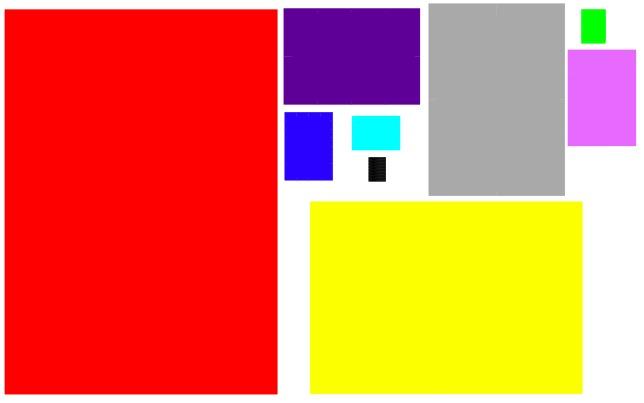Different sizes
A simple visual exploration into halving and doubling.
Problem

You could have a go at putting these in order from the smallest to the biggest.
Do you notice anything about the way they increase in size?
What about the sides?
What about the area?
Can you arrange them in a pattern which shows doubling?
Could you draw some different pictures that also show doubling?
Now, what about HALVING? Could you make an arrangement or new picture to show halving, again and again?
Student Solutions
We had just one email sent in from Connor and Nathan at St.Anthony's School in Glasgow, Scotland who listed the rectangles in order, as follows;
black, green, turquoise, blue, pink, purple, grey, yellow, red.
I wonder if anyone looked at the other questions?
Teachers' Resources
Why do this problem?
Possible approach
Key questions
Possible extension
Possible support
"A" sized paper
The international paper size standard, ISO 216, is based on the German DIN 476 standard for paper sizes. ISO paper sizes are all based on a single aspect ratio of square root of 2, or approximately 1:1.4142. The base A0 size of paper is defined to have an area of one m ².
Successive paper sizes in the series A1, A2, A3, and so forth, are defined by halving the preceding paper size along the larger dimension. The most frequently used paper size is A4 210 by 297 millimetres (8.3 × 11.7 in). The significant advantage of this system is its scaling: if a sheet with sides in the ratio of $\sqrt{2}$ is divided into two equal halves parallel to its shortest sides, then the halves will again have sides in the ratio of $\sqrt{2}$. A4 sheets are folded to make A5, A5 to A6 etc. This means that scaling doesn't compromising the ratio of the sides from one size to another as provided by office photocopiers, e.g. enlarging A4 to A3 or reducing A3 to A4. Similarly, two sheets of A4 can be scaled down and fit exactly 1 sheet without any cutoff or margins.
The advantages of basing a paper size upon an aspect ratio of $\sqrt{2}$ were already noted in 1786 by the German scientist and philosopher Georg Christoph Lichtenberg.[1] Early in the 20th century, Dr Walter Porstmann turned Lichtenberg's idea into a proper system of different paper sizes. Porstmann's system was introduced as a DIN standard (DIN 476) in Germany in 1922, replacing a vast variety of other paper formats. Even today the paper sizes are called "DIN A4" in everyday use in Germany and Austria. The term Lichtenberg ratio has recently been proposed for this paper aspect ratio.
Source: Wikpedia http://en.wikipedia.org/wiki/Paper_size
